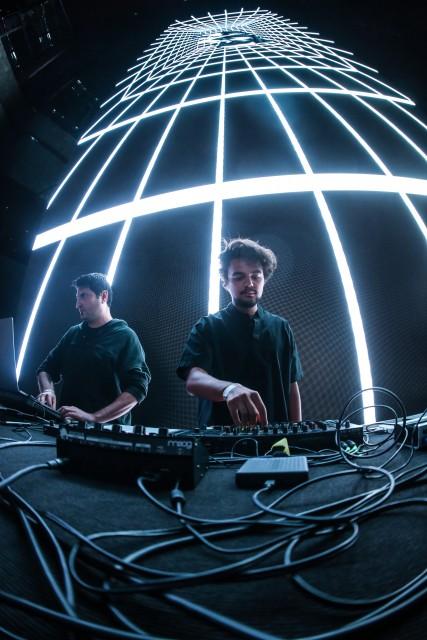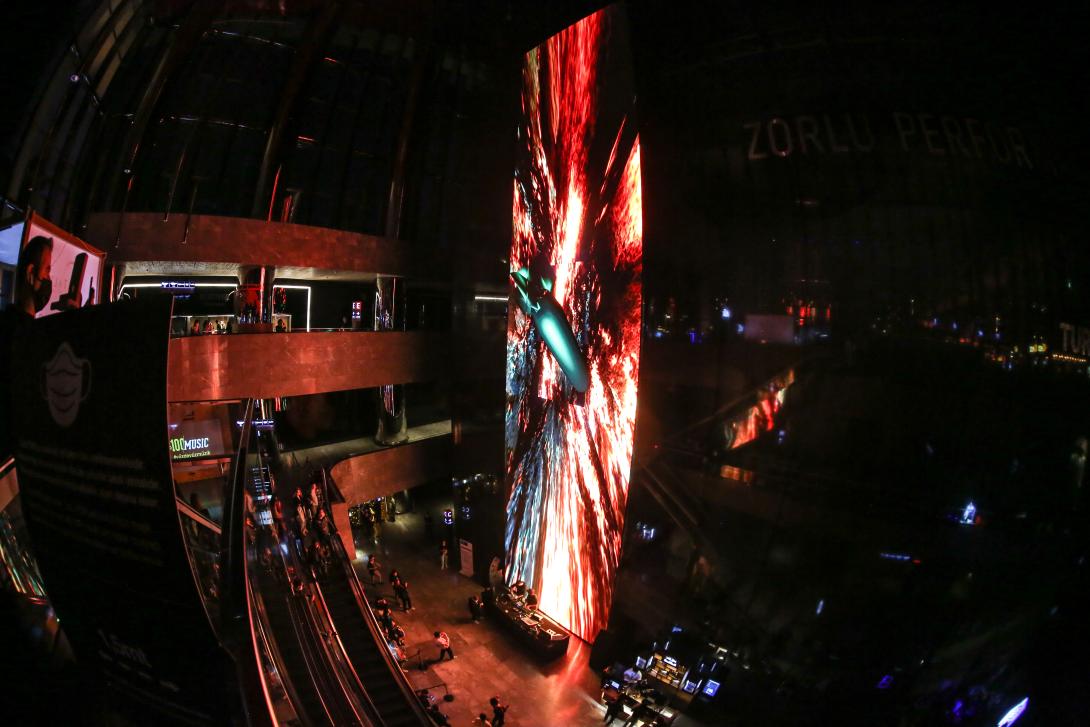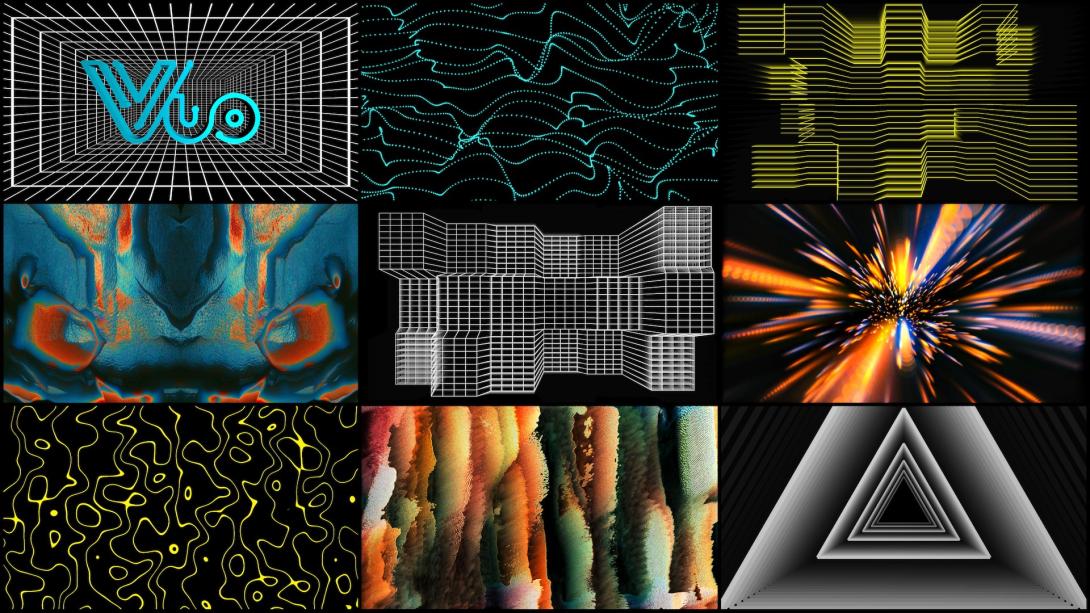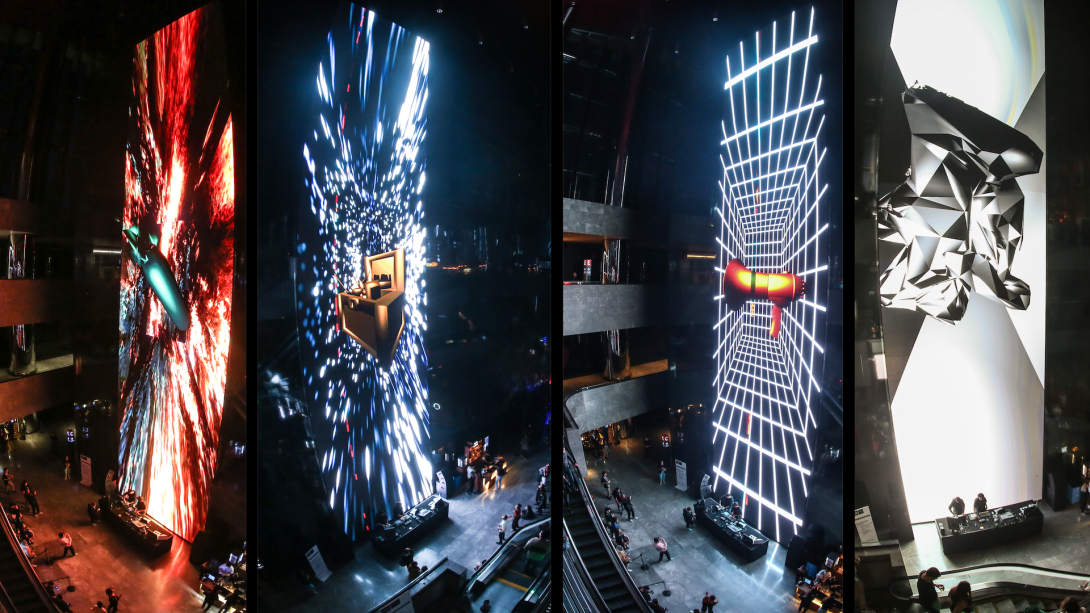
Istanbul-based audiovisual artist Huseyin Kuru knows how to translate physical spaces and aesthetics into powerful art. As part of the Motus Lumina collective, Huseyin has put together unique installations, placing an emphasis on crafting experiences by integrating sound and data for an interactive performance. Since 2005, Huseyin has lent his musical and visual skills to performances with more than 600 DJs and bands.
Part of what makes Huseyin’s body of work so compelling is his emphasis on collaboration. The Motus Lumina collective combines Huseyin’s talents with those of other artists, drawing on each other’s unique strengths for a team-up even better than its constituent parts. Huseyin also collaborates outside of Motus Lumina, including his recent piece Introversion with Kerem Demirayak, known as Karakter, for the Sónar Istanbul festival. But Huseyin isn’t just a team player when it comes to creating art — he also works to share his knowledge of techniques and tools for audiovisual production, including Vuo. Teaching individual lessons and small-group workshops in audiovisual programming, Huseyin has actively endeavored to share his experience and build the community as both a mentor and a mentee.
Recently, Huseyin described for me the productions that Motus Lumina is currently working on and hinted at some of their upcoming performances. He detailed how he has been working to connect artists with the tools they need, creating a sense of community that has been beneficial, especially during lockdown. Huseyin also spoke in depth about his recent Introversion project and described his passion for sharing his audiovisual knowledge — not just to help interested artists improve their own work but as a way to improve himself.
What audiovisual productions are you working on as Motus Lumina?
Motus Lumina is an Istanbul-based design studio working on audiovisual programming, real-time computer graphics, and interactive audiovisual experiences. We are programming visual content for various genres of music and performing real-time visuals for events and festivals. We are also developing audiovisual instruments and interactive audiovisual installations, video mapping projects, and designing audiovisual apps.
You’ve produced video art, visuals, and visual performances in a number of different locations and countries — how important is the physical space to your art and creating audiovisual spaces?
We believe that every physical space has its own story and soul. We are always trying to build a connection between our work and the story of that physical space. Besides that, when we are programming generative or interactive audiovisual content that will be exposed on a physical space, the space itself always has a big role and inspiration for defining the final frontiers of that generated artwork. The range of the frequencies or the color palette that we will use has a direct connection with the structure, light, and acoustics of that physical space.
What role does Vuo play in these current audiovisual projects?
Since January 2021, Vuo is our primary tool for programming visual content, generative audiovisual presets, programming plugins, and video effects. We use Vuo for creating geometrical compositions, textures, feedback-based visuals, text animations, audio and MIDI reactive presets, and applying real-time lights and shaders on 3D models. Recently, we have started to make print works from our generative visual content as a side project.
As Motus Lumina, we used to program all our real-time visual content and audiovisual plugins with Quartz Composer (QC). Also, we were sharing and selling these contents on our online marketplace Lumina.Space. After Apple stopped the development of QC, we started searching for a new programming language. During this process, our mentor and friend Matt Black (Coldcut) recommended Vuo to us and we started testing Vuo.
How did you switch to Vuo — what functionality or usability did Vuo provide that you were looking for?
Vuo’s interface has offered us a programming experience that we can learn very fast and intuitively. Since we have node-based programming experience, we quickly got used to the software.
Top reasons why we switched to Vuo:
- With Vuo we can program real-time visual content, visual effects, and plugins that work with VDMX and Resolume flawlessly.
- Exporting high-res videos with high FPS rates is super easy.
- We had amazing performance results when we sync our real-time 3D visuals with Ableton Live and various musical instruments via MIDI and OSC protocols.
- Vuo supports all popular data types and protocols that we need in our creative process.
Finally, we are very happy to export all our audiovisual content and plugins as interactive standalone Mac applications. It is a great feature for an artist to be able to send the final product or prototype as a standalone app.
How did you get started with your Vuo workshops, and why is it important to you to teach these tools?
After moving to Vuo, we started to share our first Vuo compositions on our social media accounts. In a very short time, we received many messages requesting online workshops from our followers and the students who have attended our workshops in the past. So we prepared a 12-hour online workshop program and sent it to the Vuo team for confirmation.
I was very excited, I remember, to prepare a workshop program for a node-based programming language that I am also very new to. I made improvements to the Vuo compositions used in the workshop based on recommendations from the Vuo team.
After I shared the workshop announcement on our social media accounts, we received many students on the same day and a few months later we started to collaborate with the Vuo Team and made this workshop officially supported by Vuo. Since then, I’ve been teaching Vuo five days a week!
[Editor’s note: With help from a grant from the state of Ohio for small businesses, the Vuo team has covered the workshop fee for many workshop participants.]
I believe that Vuo is a great tool for combining multimedia elements and creating multidisciplinary artworks and projects. In that sense, it is a great experience to share these possibilities and teach people how to put their creative ideas together. We designed this workshop for everyone — no coding knowledge is necessary. That’s why we have a lot of students from various creative fields. Our intersection zone is where visuals generate sound and sound generates visuals and we are able to play and perform them with any unconventional or conventional tools.
I think sharing the things we know is always the best way to improve ourselves. Besides being the instructor of this workshop, I also feel like a student too. It was the middle of the pandemic when we started this workshop, and while I couldn’t even leave the house during the lockdown, I met many people from all over the world and shared creative ideas with this workshop. In my opinion, all these experiences are very valuable for the students, the Vuo team, and for me.
You’ve recently been collaborating with Karaktermusic on Introversion — what makes this collaboration different from Motus Lumina and what’s next for your duo?
Kerem Demirayak a.k.a. Karakter and I have been following each other’s work and exchanging ideas about the individual projects we work on, and finally this year we decided to join forces and started working on Introversion. A few weeks later, we did our first performance at Sónar Festival.
Introversion is projecting our concerns, emotional fluctuations, and melancholic sensations we accumulated in daily life. The performance is a synthesis of generative abstract visuals with daily life imagery. Technically, we are processing all our visual content with the audio and MIDI signals coming from Kerem’s live setup. It is very important for us to shape all visuals with this sonic impact.
I can say that Introversion’s sound, story, and visuals are very intense and emotional. It speaks pretty loudly about the things it speaks about! The upcoming plan for Introversion is to perform more gigs and more make workshops and presentations on how we approach audiovisual programming. We will also have guest musicians on upcoming shows — stay tuned!

![Image of [Fever] Displacement mapping preset from Motus Lumina Facebook page, with blue and red shaded color spots with vertical line distortion.](/sites/default/files/styles/wide/public/vuo_spotlight/Motus%20Lumina%20Image.jpg?itok=iymPTbhw)


Comments